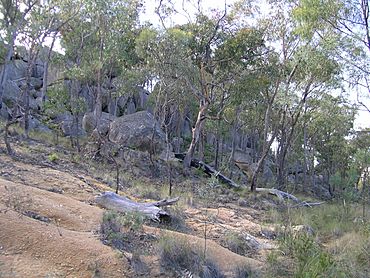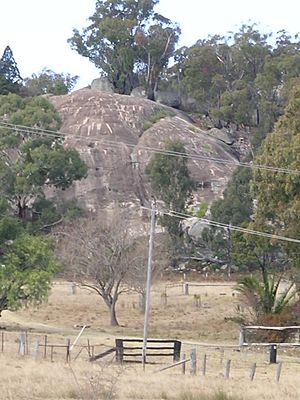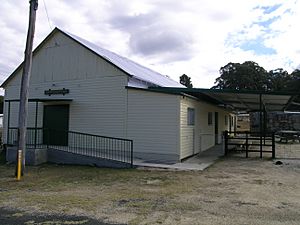Torrington, New South Wales facts for kids
Quick facts for kids TorringtonNew South Wales |
|
|---|---|

Torrington State Recreation Area
|
|
| Postcode(s) | 2371 |
| Elevation | 1,129 m (3,704 ft) |
| Location |
|
| LGA(s) | Tenterfield Shire |
| County | Clive County |
| Parish | Annandale |
| State electorate(s) | Lismore |
| Federal Division(s) | New England |
Torrington is a small village in northern New South Wales, Australia. It is part of the Tenterfield Shire area. You can find it about 29 kilometres north-west of Deepwater. It is also south-west of Tenterfield. The village is 61 kilometres from Glen Innes to its south-east.
Torrington sits on a high area called the Mole Tableland. It is very close to the Queensland border. One cool thing about Torrington is its many large rocks and rocky areas. "Goat Rock" is a well-known boulder right in the village. Just outside town, you can find "Old Mystery Face."
Contents
Discovering Torrington's Past
Torrington got its name from a town in Devon, England. In 1881, people found a lot of tin here. This discovery made many people excited. Soon, big mining companies took over from smaller miners.
Life in the Mining Boom
In the 1920s, about 500 people worked in the mines. There were sixteen machines called "batteries" that helped process the tin. The village was very busy back then. It had five general stores, a butcher, cafes, and a bakery. There were also billiard rooms, a police station, and a post office. People could go to churches and a hotel. Many sports facilities were available too.
Two smaller villages, Tungsten and Bismuth, were nearby. They were about 7 kilometres from Torrington. Today, you can hardly tell these villages ever existed.
Changes Over Time
The local post office first opened in 1882 as 'The Mole'. It was renamed 'Torington' in 1883. Then, in 1970, it became 'Torrington'. The Bismuth Post Office was open from 1912 to 1931.
In 1931, the government allowed land to be used for grazing animals. This was north of Torrington. More land was opened up for grazing over the next 50 years. However, most of the Torrington area is still natural bushland.
After World War II, the government stopped supporting tin mining. This caused the mining industry to almost completely shut down.
Other Industries and Modern Times
Torrington also had a saw mill that used local stringybark trees. This mill closed in the 1960s. Today, a small timber mill still operates nearby. It produces hardwood timber when people order it.
Sometimes, commercial mining still happens if tin prices are good. The area has large amounts of a mineral called topaz. This is interesting for both miners and people who like to search for rocks.
In 1981, Torrington celebrated its 100th birthday. It was officially called a village then. The local hotel closed in 1999. It reopened briefly in 2000 but closed for good in 2003. You can see old mining equipment, like a Cornish Buddle, at the caravan park. Today, about 85 people live in Torrington.
Understanding Droughts in Torrington
Torrington, like many places in Australia, experiences dry periods. The average rainfall for ten years up to 2000 was about 99.6 centimetres.
There have been many short dry spells. For example, in October 1991, all of northern New South Wales and southern Queensland were very dry. Another bad dry period lasted from 1994 to January 1996. Even worse, in 2002, Torrington only received about 61 centimetres of rain. In 2005, it had about 76 centimetres. A long dry period finally ended in 2006.
Exploring Torrington: Fossicking and Tourism
Mining is no longer the main activity here. Now, people come to Torrington for fossicking and tourism. Fossicking means searching for rocks and minerals. Visitors enjoy the amazing views of rocky granite formations. They also like the deep gorges and gentle streams. You can search for topaz, quartz, and many other minerals in the area. Sadly, the last general store and the caravan park closed a few years ago.
Torrington State Recreation Area
The Torrington State Recreation Area is a huge natural space. It covers more than 30,000 hectares. This area is full of wildlife. You can see the famous Old Mystery Face rock formation here. There is also Captain Thunderbolt's Lookout. Many other amazing rock shapes, streams, and waterfalls are found here.
This area is important for protecting nature. It is also used for mining, honey production, and outdoor fun. It has special cultural meaning too. You might find rare plants like the Persoonia terminalis shrub here. The endangered Torrington Pea (Almaleea cambagei) also grows in this area.
Staying Informed: Local News
Local news about Torrington is shared by the Glen Innes News. They publish news both in print and online.




